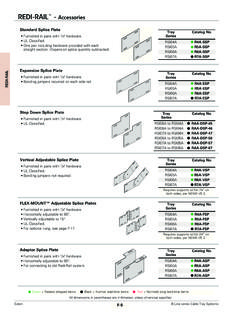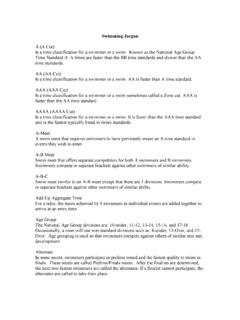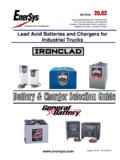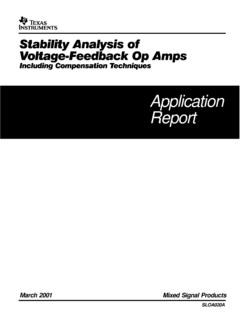Transcription of Maximizing Sales Force Effectiveness: Six Levers To ...
1 Maximizing Sales Force effectiveness : Six Levers To Capture Significant Value 2 Contents Executive Summary 3 Six Levers to Maximize Sales Force effectiveness I: Improving Lead Management 4 II: Enhancing Pipeline Management 8 III: Refining Distributor Selection and Channel Management 12 IV: Increasing Premium Mix Selling 16 V: Optimizing Sales Force Deployment 21 VI: Optimizing Product Breadth 27 3 Executive Summary I. Improving Lead Management IV: Increasing Premium Mix Selling III. Refining Distributor Selection and Channel Management V: Optimizing Sales Force Deployment Emerging from the recession, there is an opportunity and in some cases a necessity to fundamentally rethink the Sales Force In this time of change, we have identified six Levers to maximize Sales Force effectiveness which if properly executed can lead to significant value capture and market position improvement II.
2 Enhancing Pipeline Management VI: Optimizing Product Breadth 4 Maximizing Sales Force effectiveness : I. Improving Lead Management 5 Improving Lead Management Leads are the lifeblood of any Sales organization Most Sales organizations are able to generate a large volume of leads Some leads have very high value, while the vast majority generate no immediate business Low average expected value makes pursuit of leads a chore Half-hearted pursuit may result in missing big value leads Critical to successful lead management is a better understanding of the value of the lead stream and appropriate lead disposition. Goal is to Reduce number of low potential leads Improve follow-up processes to increase conversion rate The following example illustrates a successful implementation of an improved lead management system 6 14 12 8 10 Case Study: Materials Manufacturer Analysis Reveals True Value of Lead Stream $100K - 500K $50K - 100K $10K - 50K $0 - 10K Value of Sale [$] Total Number of Leads Not Sold 743 Sold 787 Number of Leads Conversion Rate Value of Closed Projects Average Expected Value 787 $ $ Average expected value of lead is low Average hides distribution of lead values 7 Case Study.
3 Materials Manufacturer Follow-Up Process Appropriate to Lead Value Inside Sales Probing Inside Sales Probing Field Sales Pursuit Do Not Pursue High Low Low Lead Value High Likelihood of Sales Enhanced lead filtering processes mapped value of lead to level of pursuit resource Benefits accrue along three dimensions Increased territory manager active selling time Increased productivity of territory manager selling Efficient pursuit of lower value leads 8 Maximizing Sales Force effectiveness : II. Enhancing Pipeline Management 9 Enhancing Pipeline Management Effective Sales organizations need to actively manage leads through entire Sales pipeline from pre-qualification to close Many times internal issues impede lead progression through the pipeline Competing priorities Lack of appropriate Sales tools Misaligned incentives and metrics Our experience has shown that healthy pipeline management demands Clearly defining strategic imperatives Providing the Sales Force with the proper training and tools Establishing and measuring key performance indicators 10 Case Study: Project Oriented Selling Organization Identifying Key Performance Indicators Critical To Success Leads Performance Metrics Sales Pipeline Sales Calls Follow-Up Close Sale Key performance indicators.
4 Rate = Number of Shipped Jobs / Qualified Leads Contribution = Profit Contribution of Each Sale Client identified that too many performance metrics caused lackluster performance We identified two metrics as the true key performance indicators 11 0%20%40%60%80%$7,500 $5,000 $2,500 $0 Gross Contribution ($/Sale) Hit Rate (%) High Performers Average: Average: $2,114 Low Performers Case Study: Project Oriented Selling Organization Active KPI Tracking Increased Overall Sales Force Performance Client measured Sales reps against KPIs, identified high performers and emulated best practices throughout to increase effectiveness 12 Maximizing Sales Force effectiveness : III. Refining Distributor Selection and Channel Management 13 Refining Distributor Selection and Channel Management Aligning with the correct channel partners is critical to the success of any Sales organization Distributors provide critical access to markets and appropriate coverage of end customers Play strategic roles in trade areas ranging from lead partner to specialist Provide critical functions such as stocking and credit Challenge is that goals and incentives are not always aligned Often times need exists to manage channel conflict Different motivations result in potential conflict over strategic role of distributor Delicate balance must be struck to offer terms and conditions that are economically attractive to all parties We recommend a five step process for optimal distributor selection 14 Optimizing
5 Distribution: 5 Topics Develop the ideal target list of new distributors Decide on channel strategy and competitive conflict Select specific partners Define the terms of the relationship Foster constructive competition A. Target Identification B. Coverage Strategy C. Partner Selection D. Strategic Terms E. Channel and Account Management trade areas distributors who cover trade areas market focus of available distributors target list that maximizes coverage across trade areas and market segments the specific areas of market segment overlap between (potentially) competing distributors the likely nature of competition and strategies of the distributors impact on existing distributors strength of individual target distributors attractiveness fit with the trade-area team strategic role expected from specific distributor (lead partner, market participant, specialist)
6 Terms for each role specific terms with individual distributors direct-to-contractor policies reps on pursuing selected partners from target list up desired distributors with appropriate terms trade area competitive interaction account plans, pricing policies, and TM calls to encourage constructive competition 15 Case Study: Commodity Manufacturer Closed Coverage Gap While Minimizing Channel Conflict Analysis revealed client had strengthened channel position in small, high service, high price point distribution Coverage gap identified with high volume, commodity oriented distributors Client differentiated offering resulting in protection of high margin distributors and penetration of high volume distributors $ $ $ $ ,0002,0003,0004,000 Trade Area Purchases [$K] Circle Size Indicates Trade Area Purchases 86% 7% Distributor 3 Distributor 5 $ $ $ $ ,0002,0003,0004,000 Trade Area Purchases [$K] Price / Pound 7% Distributor 1 Distributor 2 Distributor 3 Distributor 4 Distributor 5 50% Price / Pound Distributor 1 Distributor 2 Distributor 4 100% 86% 50% Protect Conquer 100% 86% 16 Maximizing Sales Force effectiveness : IV.
7 Increasing Premium Mix Selling 17 Increasing Premium Mix Selling The ability to sell a premium mix of goods and services is a hallmark of any successful Sales organization Increasing premium mix selling is critically important in this period of trading down The challenge is that it is often difficult to determine success drivers and emulate them throughout the organization Is the Sales Force lucky or good? If there are pockets of success, how do we inspire the under-achievers to replicate the high performers? We have observed specific steps to premium selling success Assessment and training of individual reps results in high impact 18 Case Study: Manufacturer of Industrial Products Premium Selling Performance Varies Territory Manager Sales - All Regions Premium 10% of Mix 3y Premium Volume Sales [K] 3y Total Volume Sales [K] 60 240 180 120 900 600 300 0 Premium 30% of Mix Premium 5% of Mix 19 Case Study.
8 Manufacturer of Industrial Products Patterns of Success Step TM Evaluation Score 1 Understand demand 2 Master product knowledge 3 Cultivate premium capable distributors 4 Communicate business benefits 5 Teach end customer premium selling 6 Use account plan to motivate distributors 7 Guide distributor s selling efforts High Premium Sellers Low Premium Sellers High Premium Sellers consistently outscored Low Premium Sellers along specific steps 20 Case Study: Manufacturer of Industrial Products Institutionalizing Success Elements Improved Performance Territory Manager Sales - All Regions Premium 10% of Mix 3y Premium Volume Sales [K] 3y Total Volume Sales [K] 60 240 180 120 900 600 300 0 Premium 30% of Mix Premium 5% of Mix 21 Maximizing Sales Force effectiveness : V. Optimizing Sales Force Deployment 22 Optimizing Sales Force Deployment Optimally deploying limited Sales Force resources is one of the fundamental success factors of any Sales organization Determining optimal Sales Force deployment, especially during a period of change, presents a variety of challenging trade-offs and questions including Where is the demand strongest and where is the market growing fastest?
9 Where do we have comparative advantage and bastions of strength? How do we balance effectively serving the market while keeping costs in line? We have found that the concept of market zones provides a useful framework for determining how to optimally deploy Sales resources 23 Defining Three Different Market Zones Stronghold Beachhead Lowland High Low High Low Market Zones Stronghold: High opportunity areas where company has a bastion of strength Beachhead: Battleground areas which may require focused strategies Lowland: Areas that have low potential and company strength which require an efficient model to serve Company Competitive Strength Demand Density Define Markets into three market zones based on key characteristics Tailor deployment to meet needs of different market zones 24 Product Line A Product Line B Product Line C Manufacturer sold three product lines through three separate Sales forces Analysis revealed market zones varied by product line 05010015020025010% 20% 30% 40% 90% 0% 60 squares / mile2 21% Demand Density Market Share 20 30 40 470 50 0 40% 10 80% 30% 20% 10% 0% 60 23 squares / mile2 Demand Density Market Share 01210% 0% 20% 30% 40% 50% 100% Demand Density.
10 39 WBs / mile2 17% 18% Beachhead Stronghold Lowland Market Share Average Market Zone Types Legend: Case Study: Multi-Product Line Manufacturer Market Zone Identification 25 Case Study: Multi-Product Line Manufacturer Market Zones Varied By Stage of Product Lifecycle Product Line A: New Product Regional Market Zone Definition Differences in phase of product lifecycle led to different market zone definitions for each line Product Line B: Growing Product State-Level Market Zone Definition Product Line C: Mature Product MSA vs. Rural Market Zone Definition 26 Case Study: Multi-Product Line Manufacturer Matching Strategy And Organization To Markets For Success High Low High Low Market Zones Company Competitive Strength Demand Density Sales Force strategy and organization tailored to different market zone characteristics Manufacturer was able to defend strongholds, penetrate beachheads and efficiently serve lowlands More Generalist More Specialist Hybrid With Beachhead Strategy Hybrid With Defensive Strategy 27 Maximizing Sales Force effectiveness : VI.






